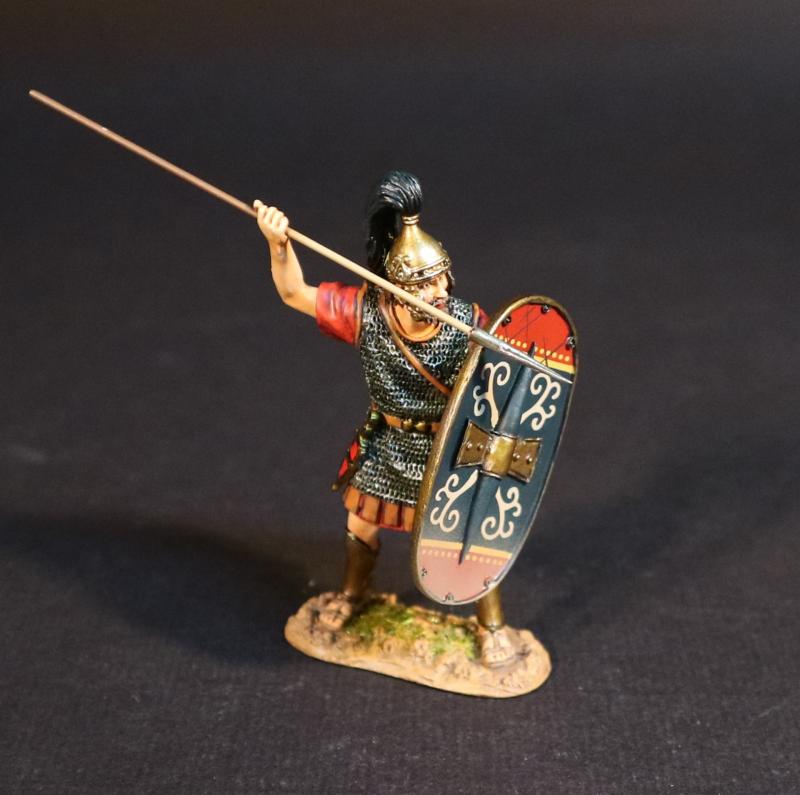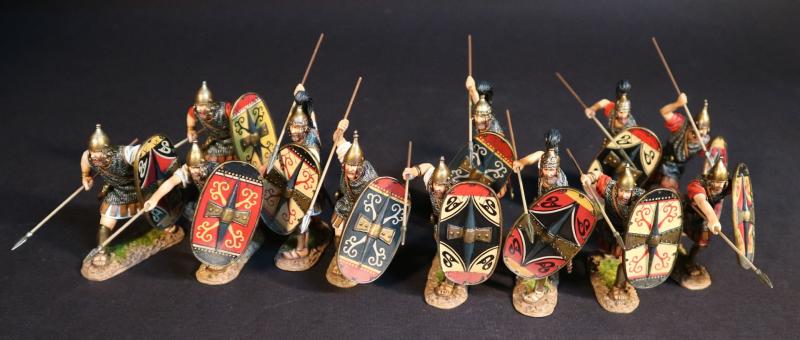Celtibarian Scutari (black, red, & pink shield), The Carthaginians, The Battle of Zama, 202 BCE, Armies and Enemies of Ancient Rome--single figure with spear & oval shield ready to thrust to thrust overhand--AWAITING RESTOCK.
$49.00
Future Release
Add to Wish List Notify Me When Available
Item Number: CTIB-01B
Celtibarian Scutari (black, red, & pink shield), The Carthaginians, The Battle of Zama, 202 BCE, Armies and Enemies of Ancient Rome--single figure with spear & oval shield ready to thrust to thrust overhand
ARMIES AND ENEMIES OF ANCIENT ROME
THE CARTHAGINIANS
THE BATTLE OF ZAMA, 202 BCE
Carthage learnt the use of elephants from fighting in Sicily against Pyrrhus of Epirus between 278 and 276 BCE. The Carthaginians quickly realized they could easily acquire African Forest Elephants which inhabited North Africa in great numbers. It was much easier to capture these elephants than import elephants from India.
It was not long before Carthage had the most powerful elephant corps in the Mediterranean world, with stables housing up to 300 elephants located in the capital. They would replace chariots as the Carthaginian’s main striking force.
The elephants primarily used by the Carthaginian armies were of the now extinct smaller African kind. They stood between 2m and 2.5m tall. These elephants were taken from the now long vanished forests of Numidia. Their primary use was to terrify the uninitiated man and horse, and they carried a single rider known as a mahout, who was armed with a javelin. Each elephant could also carry an additional soldier armed with javelins or a long spear.
It is believed that the elephants deployed at Zama did not carry infantry in howdahs on their backs. Most scholars doubt it as the forest species being smaller than Asian elephants, it is believed could not carry the additional weight. Any elephants with towers were believed to have been imported from India. However, the Egyptian Ptolemies as well as Numidian kings are recorded as having put towers on forest elephants, and the Roman poet Juvenal mentions towers on Hannibal’s elephants.
In 218 BCE, the Second Punic War began and the famous Carthaginian general Hannibal traversed the Alps to invade Italy with an army that included 37 war elephants, which were believed to be mostly African. In the course of that arduous crossing, many men, cavalry and draught animals were lost, but apparently (according to ancient sources) not a single elephant. The elephants were to contribute to Hannibal’s first victory in Italy, on the Trebbia river, where they frightened the Roman cavalry and routed the Roman auxiliaries. Shortly after the battle, all but one elephant died. It is not known why? Maybe the after effects of exhaustion suffered during the crossing, or some disease incurred during the campaign, are all distinct possibilities.
CELTIBERIAN SCUTARIUS
Although initially the Carthaginian army was composed only of Citizens of Phoenician origin, it saw increased recruitment of contingents of mercenaries and allies a necessity in order to realize the policy of imperial expansion. This use of mercenaries saved the metropolitan population from heavy casualties that were not easily replaceable, and it also reflected the Carthaginian concept of war, which was considered simply as an extension of business. With the enlargement of Punic economic interests the army became more exclusively mercenary and progressively came to include almost all the peoples of the central and western Mediterranean area.
The success of Carthage in bringing most of central and southern Iberia under its control was a crucial element in their continued ability to pursue the war against Rome. Iberian troops probably fell into two rough classifications, the Scutarii and the Caetratii. These types basically defined the type of shield, with the Scutum being a large flat oval shield with a wooden spine and metal boss. The Caetra was a flat, smaller round shield with a circular metal boss. Both troop types were armed with a dagger and sword, as well as spears for hand to hand fighting and for throwing.
Released in DECEMBER 2024.

